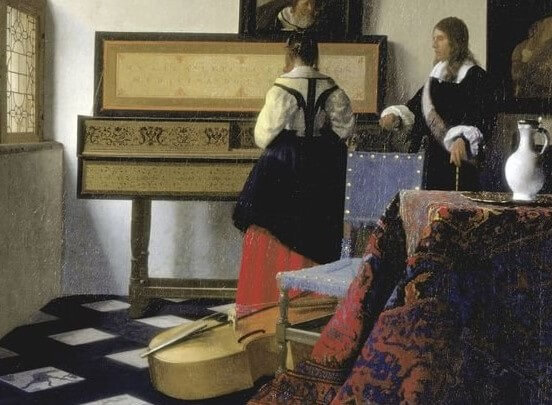As we ring in December and, with it, the start of the holiday season, our thoughts turn to a suitably festive theme in art: music. From the Old Masters to the Contemporary era, artists have drawn inspiration from music, whether it’s a literal depiction of a musician or an instrument, or an abstract composition inspired by a particular musical genre.
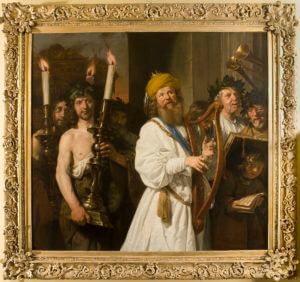

J. de Bray, David and the Return of the Ark of the Covenant, 1670, sold by Dickinson to a European Museum
It’s not surprising that there are many Old Masters featuring musical subjects given the numerous Biblical references to music. Artists such as Raphael painted images of St. Cecilia, patron saint of musicians, for altarpieces and private chapels while King David and his harp provided a subject for Dutch Golden Age painter Jan de Bray. For other Old Masters, the theme of music was used as an allegory – for the sense of hearing, for instance, as part of a series representing the five senses; or as an allegory of romance, as we see in paintings such as Johannes Vermeer’s The Music Lesson (1662-65, Royal Collection, London). And, of course, musical instruments appear frequently in portraiture, either as a sign of the social status of a sitter – such as we see in Frederick Kerseboom The Elder’s Sir John Langham, Bt. (1671 – 1747), as a boy aged 12, playing the viola da gamba – or because the subject of the portrait is a celebrated professional musician, such as the cellist Carl Friedrich Abel, painted by his close friend Thomas Gainsborough (c. 1765, National Portrait Gallery, London). We even see still lifes of musical instruments by artists such as Evaristo Baschenis, active in 17th century Bergamo.
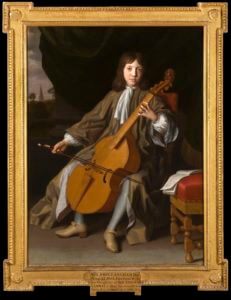

F. Kerseboom The Elder, Sir John Langham, Bt. (1671 – 1747), as a boy aged 12, playing the viola da gamba, 1683, available for sale at Dickinson
Artists active in the 19th century were no less enthusiastic about musical subjects. Leading French Academic painter Jean-Léon Gérôme regularly populated his Orientalist fantasies with musicians, conjuring up the sounds of the harem or bath house. Among the Impressionists, Edgar Degas was particularly known for his depictions of concerts at the Paris Opera, sometimes focusing on the ballerinas onstage and at other times looking more closely at the members of the orchestra in the pit. And Pierre-Auguste Renoir’s Two young girls at the piano uses the instrument as a signifier of the subjects’ upper-middle-class status (1892, The Metropolitan Museum, New York). In America and Britain, Gilded Age painter James Abbott McNeill Whistler regularly drew parallels between art and music, frequently calling his paintings ‘arrangements’, ‘harmonies’ or ‘nocturnes’ . Although his subjects were rarely musical, Whistler aimed for a sense of tonal harmony in his compositions that was very similar to those created by composers.
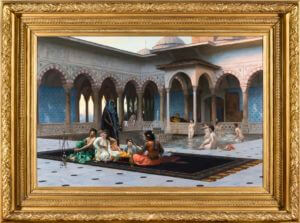

J.L. Gérôme, La Terrasse du Sérail, 1886, sold by Dickinson to a private collector
20th century artists were broad in their interpretations of, and the ideas they took from, musical subjects and themes. Picasso, for instance, frequently incorporated musical instruments into his paintings, collages and sculptures – but using an abstracted or Cubist lexicon. His great friend and rival Henri Matisse, meanwhile, took jazz music as the inspiration for his innovative 1947 book Jazz, with illustrations taken from his cut and pasted paper collages . Modern jazz melodies and the vibrant soundtrack of New York City in particular inspired the title of Piet Mondrian’s De Stijl masterpiece Broadway Boogie Woogie (1942-43, The Museum of Modern Art, New York) as well as Stuart Davis’s Men without Women, a mural commissioned for Radio City Music Hall at Rockefeller Center (1932, The Museum of Modern Art, New York). In the Post-War era, when the modern cult of celebrity really exploded, musicians such as Mick Jagger, Barbra Streisand and Judy Garland featured in the iconic Pop Art portraits of Andy Warhol.
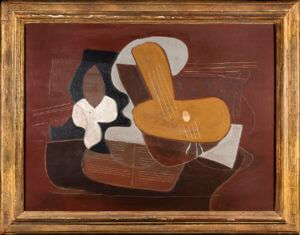

P. Picasso, Mandoline et portée de musique, 1923 or 1924, sold by Dickinson to a private collector
In the 21st century, the close ties between art and music show no signs of loosening – whether that’s demonstrated by Kanye West’s choice of Japanese artist Takashi Murakami to design a cover for his third studio album, Graduation, released in 2007; or by a musician like Bob Dylan who also works as a visual artist. With the variety of options available, there is plenty to fascinate any lover of both art and music!
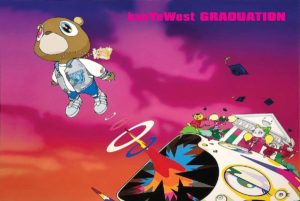

T. Murakami, album cover for Kanye West’s Graduation, 2007


